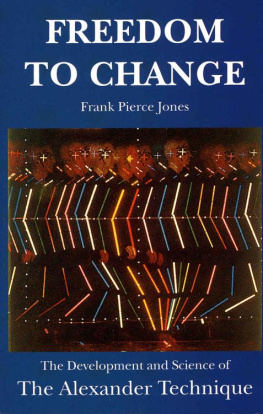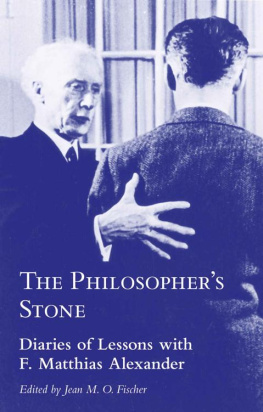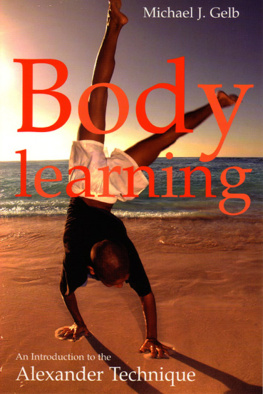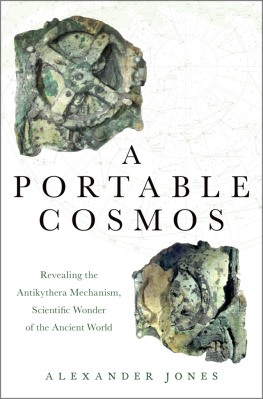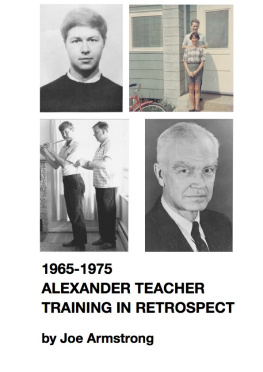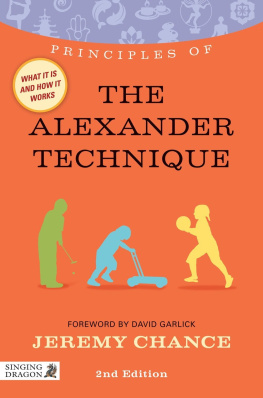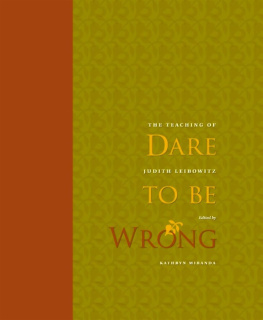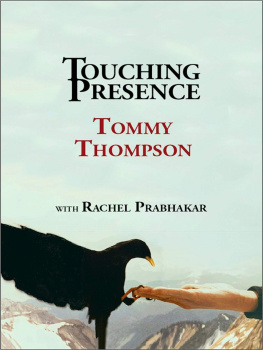Frank Pierce Jones
Freedom to Change

F. Matthias Alexander (18691955)
Frank Pierce Jones
Freedom to Change
The Development and Science of
The Alexander Technique
Introduction by J. McVicker Hunt
Foreword by Ted Dimon

mouritz.org
First published 1976 as Body Awareness in Action by Schocken Books, New York
Second edition 1979.
Third edition published May 1997 by
Mouritz
Reprinted March 2003.
Reprinted with minor emendations October 2012.
Reprinted June 2016.
Reprinted September 2019.
Kindle edition June 2021.
Appendix E edited by Jean M. O. Fischer
Glossary and selected bibliography prepared by Richard A. Brown
1997 The Estate of Frank Pierce Jones
ISBN-10: 0952557479
ISBN-13: 978-0952557470
A CIP Catalogue record for this book is available from the British Library
Cover design, layout and typesetting by Jean M. O. Fischer
Contents
Introduction
This book offers a variety of things seldom attempted in a single work, but here they are combined naturally and successfully. In it, Frank Jones takes his readers from an autobiographical, subjective account of his experience with the Alexander Technique to an objective, data-based theory of the mechanism which accounts for the subjective sense of kinaesthetic lightness that is its hallmark. Along the way, Jones describes what led the originator to develop the Technique and how he did it. He synopsizes the successive works that the originator, F. Matthias Alexander, wrote and the impressions that they, along with the experience of the Technique, made on such illustrious figures as Dr. George Ellett Coghill, Sir Stafford Cripps, John Dewey, Aldous Huxley, James Harvey Robinson, Bernard Shaw and Sir Charles Sherrington. A chapter with detective-story quality on the successful court action brought in South Africa by F. M. Alexander against the editors of Manpower for an article accusing him of false claims introduces the need for research showing at least the physical equivalents of the great mental experience of kinaesthetic lightness. The major contribution of the book is Joness description of his methods, which he derived from experimental psychology, and the results of his research. Joness results go a long way toward fulfilling this need for the physical equivalents. Finally, he synthesizes the results from his own research with knowledge of anatomy, mechanics and physiology to create a testable theory of the mechanism, and presents his views of the teaching process. It is a marvellous literary and scientific achievement for a lifetime, but it all came in the latter half of Joness life. At age 33, he was still a classical scholar teaching Greek at Brown University. Before his untimely death, Jones considered Freedom to Change as the title of this work. By this freedom, he referred to what must be learned in the Technique to permit one to change deliberately ones use of oneself, but his life and his work are a splendid example of an extension of such a limited semantic reference.
The Technique was developed by F. Matthias Alexander, who was giving one-man recitations from Shakespeare and other authors in the 1890s. When hoarseness and loss of voice that rest and medi-cal aid would not cure incapacitated him, Alexander decided that something he was doing to himself while reciting must be causing the trouble. With a special arrangement of mirrors, he came to see that whenever he began to recite he rotated his head backward and down and so depressed his larynx that he was forced to breathe in audible gasps. He learned gradually that he could consciously inhibit this stressful pattern. Once he had learned this, he found that he could initiate new activity toward any end or goal he might choose. Achieving this inhibition called for concentration on what he termed the means-whereby principle to avoid reversion to the stressful habitual pattern in seeking to achieve the end he had in view. Thus, end-gaining became a bad word. When he could resume his reciting without a return of the hoarseness, he shared his experience. This led others to seek help with similar vocal problems from him and his brother, A.R. Alexander, who joined him in what they came to call the work. Gradually they developed a way of teaching the Technique that prompted a prominent surgeon in Sydney to send the brothers to London with letters of introduction to actors and physicians in order to provide them with a wider and more influential audience.
F. M. Alexander soon began writing, first pamphlets and then books, about the Technique, but it has always been difficult to characterize and describe in words. His effort to communicate the means of inhibiting habitual and damaging use of the body in order to achieve this kinaesthetic lightness in action led, as is always the case with new domains of concern and investigation, to special terminology. The result was instructions containing such terms as concentrate on the means whereby rather than end-gaining, think of the head as forward and up but do not actively thrust it forward or up, and such theoretical constructions as position of mechanical advantage, primary control and faulty sensory appreciation. Although such words by themselves failed to communicate, the Alexanders could quickly use their hands to induce in nearly anyone who would expose himself to a lesson a relationship among head, neck, shoulders and back that induced a dramatic impression of kinaesthetic lightness in action. So long as one retained this new postural relationship (primary control), one could readily carry out common actions without the accustomed sense of effort and strain. This impression of kinaesthetic lightness from a single demonstration persists, at least for a short time, and memory of it lingers for life. Moreover, once an individual had learned to achieve the new postural relationship (primary control) of the Alexander Technique on his own initiative, stress-produced problems such as, for example, Alexanders hoarseness, disappear. Although few physicians have ever become attracted to the Technique for therapeutic purposes, Dr. Wilfred Barlow and a few others have reported finding it useful in such varied conditions as peptic ulcer, spastic colon, ulcerated colitis, eczema and rheumatoid arthritis as well as tension headaches, asthma, low-back pain and fibrositis.
Although F. M. Alexander wrote in captivating fashion about the Technique, his words as such seldom elicited faith in its efficacy and validity. It was undoubtedly demonstrations of the dramatic experience of kinaesthetic lightness coupled with relief from distressful symptoms of misuse in those who learned through lessons to achieve primary control voluntarily, that convinced such figures as Sir Stafford Cripps, John Dewey, Aldous Huxley, James Harvey Robinson and Bernard Shaw of its validity. Aldous Huxley introduced F. M. Alexander as the character of Miller, a redemptive figure in the guise of a medical anthropologist, who showed the hero of his novel, Eyeless in Gaza , how to change. Huxley gave the Technique a more formal endorsement in Ends and Means . Huxley was a pupil who came back repeatedly whenever distressful symptoms convinced him that his use of himself had again become habitually wrong in some fashion. John Dewey was one of Alexanders earliest American pupils. In 1918, he wrote an introduction to a new American edition of Alexanders book entitled Mans Supreme Inheritance . Dewey considered that the Alexander Technique provided a demonstration of the unity of body and mind. With progress as a pupil, he reported an improvement in his vision and in his breathing and in ability to hold a philosophical position calmly with ability to change it if new evidence warranted.

